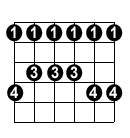Take a look at the minor scale pattern diagrams below:
Now forget the fancy name and look at the actual pattern. Remember that it is a movable pattern, so we can play this anywhere on the neck of the fretboard depending on what
key we want to play in.
As an example let’s say we wanted to practice the scale pattern in the key of G (or Gm). First we would find our root note which would be the G note on the 6th string, because the second diagram above shows us that the root note is on the 6th string (low E). We can either play the G note on the 3rd fret or an octave higher at the 15th fret.
Okay, so we’ve found our root note and are ready to play up and down the scale-each note in sequence from lowest note in the scale to the highest note in the scale and then back down again. This is how it would be played:

See, if we know that the root note is on the 3rd fret, we know the rest of the notes in the scale pattern follow in sequence:

Take a look at scale patterns like this: learning one pattern is like learning 12 scales, because you can play the pattern in 12 keys.
